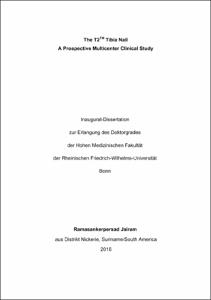Jairam, Ramasankerpersad: The T2TM Tibia Nail : A Prospective Multicenter Clinical Study. - Bonn, 2016. - Dissertation, Rheinische Friedrich-Wilhelms-Universität Bonn.
Online-Ausgabe in bonndoc: https://nbn-resolving.org/urn:nbn:de:hbz:5n-43286
Online-Ausgabe in bonndoc: https://nbn-resolving.org/urn:nbn:de:hbz:5n-43286
@phdthesis{handle:20.500.11811/6658,
urn: https://nbn-resolving.org/urn:nbn:de:hbz:5n-43286,
author = {{Ramasankerpersad Jairam}},
title = {The T2TM Tibia Nail : A Prospective Multicenter Clinical Study},
school = {Rheinische Friedrich-Wilhelms-Universität Bonn},
year = 2016,
month = jun,
note = {In this prospective multicenter clinical study 102 patients with a tibial fracture were operated with the reamed T2TM Stryker tibia nail system in 3 European Level 1 Traumacenters during 01-2003 to 12-2004. We documented demographic (e.g. age, gender), preoperative (e.g. trauma cause, fracture type), general operative (e.g. surgery time, blood loss), and postoperative data (e.g. radiologic bone healing, weight bearing, activities of daily living, return to work, anterior knee pain). The follow-up assessments took place at 4-6 weeks (n = 62), 4 months (n = 53) and 12 months (n = 71) after suegery.
There were 63.7 % male and 36.3 % female patients with a mean age of 42 ± 16 years. Most common were AO 42-B1-B3 fractures (45.1 %), followed by simple (AO 42-A1-3, 24.5 %) and complex diaphyseal fractures (AO 42-C1-3, 17.6 %). The rest of 15 fractures consisted of 10 distal (AO 43-A1-3, AO 43-B2, AO 43-C1-3) and 5 proximal fractures (AO 41 A2-3, AO 41-C3). 65 patients (63.7 %) had been involved in high-, and 37 patients (36.3 %) in low-energy trauma. Mostly, the accidents had occurred in traffic (31.4 %), on road as pedestrian (22.5 %), or at home (22.5 %). Only 36 patients (35.2 %) had a single tibia fracture, in 51 patients (50.0 %) the fibula was fractured, too, and 15 patients (14.7 %) had been polytraumatized.
After 12 months bone healing was radiologically confirmed in 91.5 % (n = 65/71). 76.1 % (n = 54/71) had returned to work and 74.7 % (n = 53/71) were able to work with full previous capacity. The mean pain score decreased from 3.1 ± 1.2 (4-6 weeks) to 2.8 ± 2.2 (4 months) to 2.3 ± 1.7 points (12 months). After 12 months, 13 patients suffered from anterior knee pain, which was mild in 12 patients so that they could work and bear weight. One polytraumatized patient showed a pain score of 8 points due to pseudarthrosis and needed several reoperations.
In a total of 14 patients a dynamisation of the nail had to be performed due to delayed healing and/or screw problems. Revision surgery had been performed in 7/102 patients (6.9%). In 3 patients the revision was indicated because of a malrotation due to screw breakage, in 2 patients because of pain by the proximal screws, and in 2 patients because of screw loosening with the risk of skin perforation.
Our study about the T2 TM nail system showed results comparable with other studies regarding intramedullary reamed nailing and underlines the hypothesis that this osteosynthesis method is effective and exhibits relatively few complications,},
url = {https://hdl.handle.net/20.500.11811/6658}
}
urn: https://nbn-resolving.org/urn:nbn:de:hbz:5n-43286,
author = {{Ramasankerpersad Jairam}},
title = {The T2TM Tibia Nail : A Prospective Multicenter Clinical Study},
school = {Rheinische Friedrich-Wilhelms-Universität Bonn},
year = 2016,
month = jun,
note = {In this prospective multicenter clinical study 102 patients with a tibial fracture were operated with the reamed T2TM Stryker tibia nail system in 3 European Level 1 Traumacenters during 01-2003 to 12-2004. We documented demographic (e.g. age, gender), preoperative (e.g. trauma cause, fracture type), general operative (e.g. surgery time, blood loss), and postoperative data (e.g. radiologic bone healing, weight bearing, activities of daily living, return to work, anterior knee pain). The follow-up assessments took place at 4-6 weeks (n = 62), 4 months (n = 53) and 12 months (n = 71) after suegery.
There were 63.7 % male and 36.3 % female patients with a mean age of 42 ± 16 years. Most common were AO 42-B1-B3 fractures (45.1 %), followed by simple (AO 42-A1-3, 24.5 %) and complex diaphyseal fractures (AO 42-C1-3, 17.6 %). The rest of 15 fractures consisted of 10 distal (AO 43-A1-3, AO 43-B2, AO 43-C1-3) and 5 proximal fractures (AO 41 A2-3, AO 41-C3). 65 patients (63.7 %) had been involved in high-, and 37 patients (36.3 %) in low-energy trauma. Mostly, the accidents had occurred in traffic (31.4 %), on road as pedestrian (22.5 %), or at home (22.5 %). Only 36 patients (35.2 %) had a single tibia fracture, in 51 patients (50.0 %) the fibula was fractured, too, and 15 patients (14.7 %) had been polytraumatized.
After 12 months bone healing was radiologically confirmed in 91.5 % (n = 65/71). 76.1 % (n = 54/71) had returned to work and 74.7 % (n = 53/71) were able to work with full previous capacity. The mean pain score decreased from 3.1 ± 1.2 (4-6 weeks) to 2.8 ± 2.2 (4 months) to 2.3 ± 1.7 points (12 months). After 12 months, 13 patients suffered from anterior knee pain, which was mild in 12 patients so that they could work and bear weight. One polytraumatized patient showed a pain score of 8 points due to pseudarthrosis and needed several reoperations.
In a total of 14 patients a dynamisation of the nail had to be performed due to delayed healing and/or screw problems. Revision surgery had been performed in 7/102 patients (6.9%). In 3 patients the revision was indicated because of a malrotation due to screw breakage, in 2 patients because of pain by the proximal screws, and in 2 patients because of screw loosening with the risk of skin perforation.
Our study about the T2 TM nail system showed results comparable with other studies regarding intramedullary reamed nailing and underlines the hypothesis that this osteosynthesis method is effective and exhibits relatively few complications,},
url = {https://hdl.handle.net/20.500.11811/6658}
}






